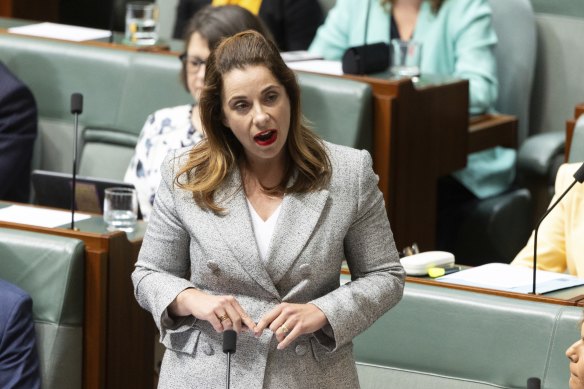Baby Boomers who can afford to pay would be asked to contribute more to their aged care costs under an anticipated shake-up of how both residential and home care are funded for older Australians.
A federal government taskforce has advised Aged Care Minister Anika Wells to reform the way aged care services are means-tested to improve equity and inject new funds into a system already costing taxpayers more than $30 billion a year.

Aged Care Minister Anika Wells in June sent a strong signal that the government would expect more contributions from Australians in return for an improvement in the quality of care.Credit: Alex Ellinghausen
Its report will be published this month and leans more towards raising consumer co-contributions, rather than options such as a taxpayer levy, in its blueprint for making the sector sustainable as Australia’s ageing population seeks out services with higher expectations of quality.
While the Older Persons Advocacy Network said it understood the reasons for greater user contributions, it warned this must come with strong safety net provisions and greater transparency, and lead to improved quality of services rather than provider profits.
Over the next decade alone, the independent Parliamentary Budget Office estimates the cost of aged care will climb by more than 82 per cent – or almost $29 billion – to $63.6 billion in 2033-34. The government’s response to the taskforce recommendations is expected around the time of the May budget.
At present, 96 per cent of care costs in residential aged care are paid by taxpayers and just 4 per cent comes from user contributions because an individual’s means-tested payments are capped around $33,000 a year, or $78,500 over a lifetime.
Those thresholds, as well as how the family home is counted in means tests, would be reconsidered under the taskforce advice. The system counts the family home only to a maximum value of $198,000, meaning someone with a property worth $300,000 is assessed the same as another with a home worth $3 million.
The views of the taskforce have been made increasingly clear over a series of communiques, which have noted that “the wealth of aged care participants is increasing while the proportion of working-age people is shrinking”.
The daily living fee that people in residential aged care pay for services such as meals, laundry and cleaning – which is set at $61 a day, or 85 per cent of the age pension – could be re-evaluated and lifted for those who have greater means.
People who can afford it and receive home care packages would also pay more; their current means-tested care fees are capped at $13,000 a year, or $78,500 over a lifetime, leaving the government to cover about 95 per cent of costs.
In addition, the taskforce has looked at whether superannuation should play a role in aged care.
Craig Gear, chief executive of the advocacy network, said user contributions needed to be progressive and staged in a similar way to the tax system. He also said choice was the most important factor when determining how people would pay their co-contributions.
“Just because someone is not on the pension does not mean they aren’t in financial strain, especially with the cost of living at the moment. People are still finding contributing costs hard to meet. Some people can be asset rich and cash poor,” he said.
“People still need to be able to have good quality life, which means being able to pay for clothing, going out to the movies, doing other things to stay connected to their community. We don’t want this to drive people into poverty [or] to not be able to afford basic things in life that bring joy and comfort.”
In a National Press Club speech announcing the taskforce in June last year, Wells sent a strong signal that the government would expect more contributions from Australians in return for an improvement in the quality of care.
“You have to say that if we’re not prepared to accept that cinder-block, linoleum-floor, four-bed room any more, then we need to work out how we’re going to pay for it,” she said.
“Plenty of people have said: ‘I am prepared to pay for an innovative, excellent model of care – I just can’t find it’.”
Aged care providers have advocated lifting user contributions for those who can afford it as the best way to boost profitability in a sector where two-thirds of providers say they are operating at a loss.
They argue that is fairer to younger generations than a taxpayer levy, which has been floated in various forms by the aged care royal commissioners.
But the advocacy network said older Australians were concerned that providers were seeking to subsidise care for people with limited means by charging more to people with greater means.
Cut through the noise of federal politics with news, views and expert analysis. Subscribers can sign up to our weekly Inside Politics newsletter.